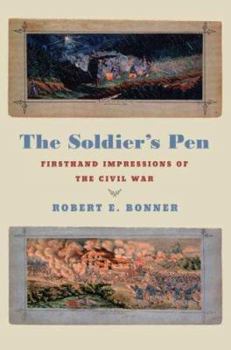The Soldier's Pen: Firsthand Impressions of the Civil War
Select Format
Select Condition 
Book Overview
They are all infantrymen; none were commissioned officers. One is a German-speaking artist whose sole record is nineteen stunning watercolors that cover a year's enlistment. Another is a free black... This description may be from another edition of this product.
Format:Hardcover
Language:English
ISBN:0809087448
ISBN13:9780809087440
Release Date:November 2006
Publisher:Hill & Wang
Length:248 Pages
Weight:0.05 lbs.
Dimensions:1.1" x 6.4" x 9.2"
Customer Reviews
2 ratings
The Soldiers Pen
Published by Thriftbooks.com User , 15 years ago
This book delivers only a topical overview of the day to day life of a Civil War soldier. As the title suggest, Robert Bonner uses actual letters from the soldier in the field that were sent home and kept. There were slim chances of a letter from home being kept by a soldier in the field, under camp conditions. The author writes a brief introduction about the men he chose to feature in the book. There are thousands of such archived letters and hundreds more have just recently been made available to researchers. This book is more of a "Cliff Notes" introduction into the social side of the Civil War soldier.
Reading Other People's Mail
Published by Thriftbooks.com User , 15 years ago
In The Soldier's Pen, Robert E. Bonner - an assistant professor of history at Michigan State University and the author of two previous books on the Civil War - provides Civil War enthusiasts and scholars with extended excerpts from the letters, diaries, and artwork from sixteen Union and Confederate soldiers. The book is an admirable accomplishment in terms of accessibility, relevance, interpretation, and in fulfilling the author's own stated mission. In his Introduction, Bonner admits that though "historians are loath to admit it, there is an illicit thrill that comes with reading other people's mail." (p. 8). He attributes this "thrill" to the sense of discovery that comes from reading and studying documents that were created by soldiers in private moments and intended for a private audience. Bonner has done readers a tremendous favor by providing access to previously unpublished material held in the famous Gilder Lehrman Collection (and now on deposit at the New York Historical Society), and allowing others the same sense of discovery. In terms of relevance, Bonner's selections dispel any modern conceit one might have that Civil War soldiers weren't as funny, clever, cynical, disgusted, romantic, prurient, etc., as the modern soldier. Whether commenting on "War Republicans," "Peace Democrats," presidential elections, race relations, incompetent officers, desertion, marriage, suffering of civilians, etc., the reader will have a sense that we have been there before. In terms of interpretation, Bonner expertly and sensitively weaves the letters, diaries, and artwork into the larger context of the Civil War. In seven chapters, he covers the importance of regular correspondence between soldiers and their families, army life, combat, commitment to (and disaffection with) Union war aims, the fading prospects of the Confederacy, African-American soldiers, and - coming full circle - the importance of surviving letters as family heirlooms and national treasures. For his part, Bonner states that a central aim of his book was to "restore soldiers' individuality." (p. 4). To be sure, he is not the first scholar to draw on soldier correspondence and diaries to provide insights into the lives of Civil War soldiers and sailors. Still, Bonner makes the salient point that previous studies often turn into a "collective portrait," drawing on snippets from dozens, if not hundreds, of pieces of correspondence to examine how "they" marched, fought, and returned home. By concentrating his study on longer excerpts from fewer soldiers, Bonner is able to avoid the trap and instead maintain the personal in what he deems an impersonal war. The reproduction of more than a dozen drawings from the sketchpad of an anonymous Massachusetts infantryman - known only as "George" - is worth the price of the book. If not as talented, this soldier's drawings of the vagaries of soldier life are every bit as comical and insightful as Bill Mauldin's famous "Willie and Joe"






